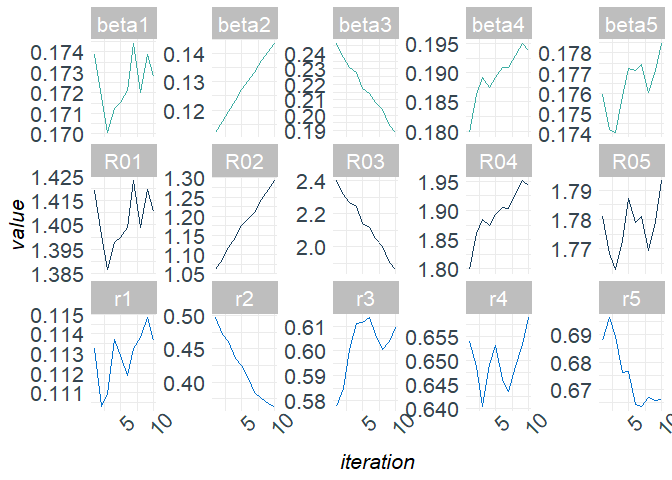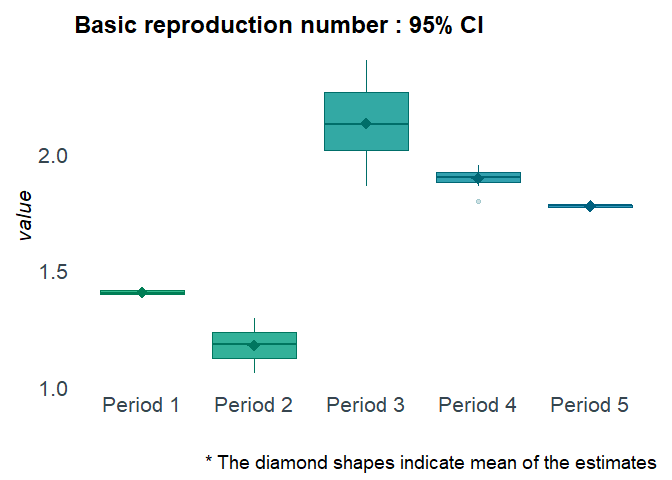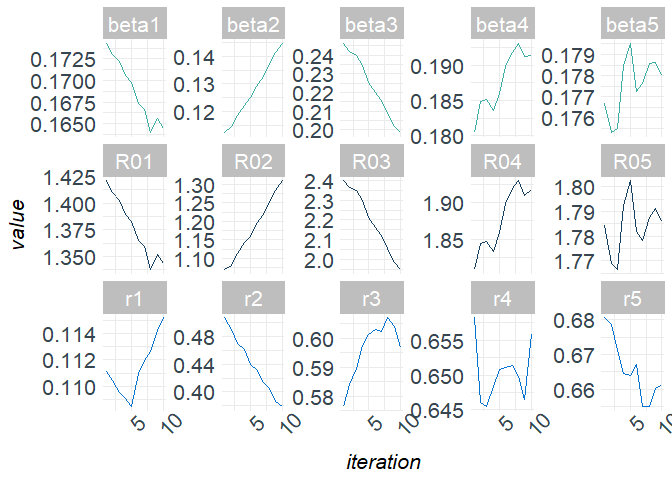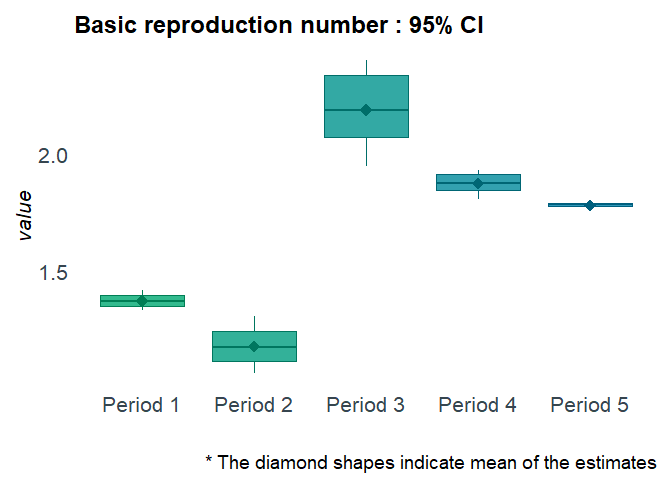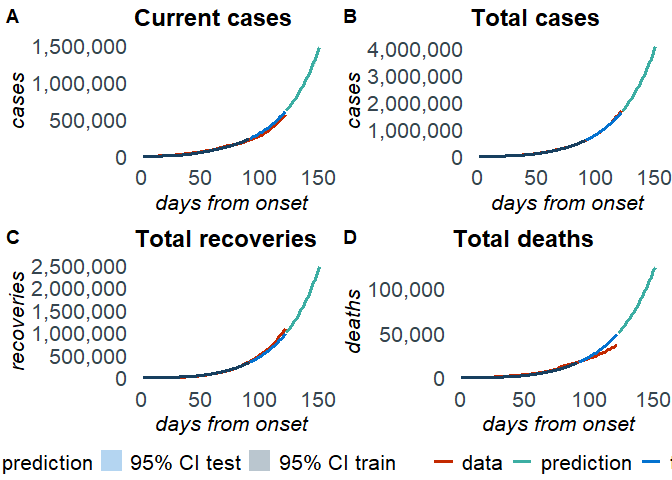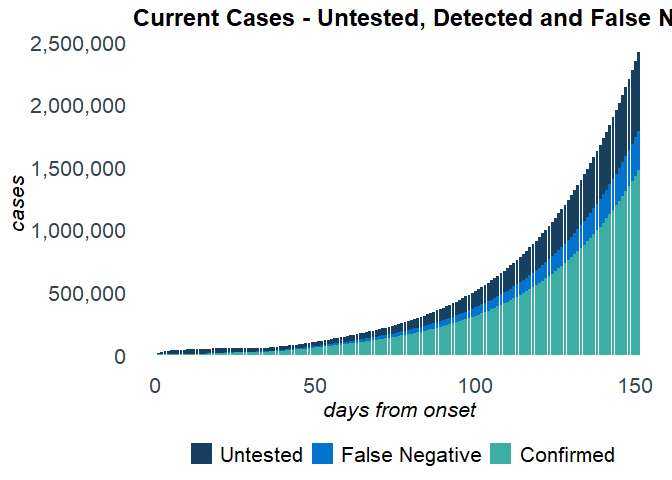** This is the old repository. The new repository is at https://github.com/umich-biostatistics/SEIRfansy
This R package fits Extended Susceptible-Exposed-Infected-Recovery
(SEIR) Models for handling high false negative rate and symptom based
administration of diagnostic tests.
If the devtools package is not yet installed, install it first:
install.packages('devtools')# install SEIRfansy from Github:
devtools::install_github('umich-biostatistics/SEIRfansy') Once installed, load the package:
library(SEIRfansy)
#> Registered S3 methods overwritten by 'car':
#> method from
#> influence.merMod lme4
#> cooks.distance.influence.merMod lme4
#> dfbeta.influence.merMod lme4
#> dfbetas.influence.merMod lme4For this example, we use the built-in package data set covid19, which
contains dailies and totals of cases, recoveries, and deaths from the
COVID-19 outbreak in India from January 30 to September 21 of 2020.
You will need the dplyr package for this example.
library(dplyr)
#>
#> Attaching package: 'dplyr'
#> The following objects are masked from 'package:stats':
#>
#> filter, lag
#> The following objects are masked from 'package:base':
#>
#> intersect, setdiff, setequal, unionTraining data set:
For training data, we use cases from April 1 to June 30
train = covid19[which(covid19$Date == "01 April "):which(covid19$Date == "30 June "),]Testing data set:
For testing data, we use cases from July 1 to July 31
test = covid19[which(covid19$Date == "01 July "):which(covid19$Date == "31 July "),]Data format for multinomial and Poisson distribution:
train_multinom =
train %>%
rename(Confirmed = Daily.Confirmed,
Recovered = Daily.Recovered,
Deceased = Daily.Deceased) %>%
dplyr::select(Confirmed, Recovered, Deceased)
test_multinom =
test %>%
rename(Confirmed = Daily.Confirmed,
Recovered = Daily.Recovered,
Deceased = Daily.Deceased) %>%
dplyr::select(Confirmed, Recovered, Deceased)
train_pois =
train %>%
rename(Confirmed = Daily.Confirmed) %>%
dplyr::select(Confirmed)Initialize parameters:
N = 1341e6 # population size of India
data_initial = c(2059, 169, 58, 424, 9, 11)
pars_start = c(c(1,0.8,0.6,0.4,0.2), c(0.2,0.2,0.2,0.25,0.2))
phases = c(1,15,34,48,62)If interest is in model estimation but not prediction, then use
SEIRfansy(). Otherwise, use SEIRfansy.predict() (see below).
?SEIRfansycov19est = SEIRfansy(data = train_multinom, init_pars = pars_start,
data_init = data_initial, niter = 1e3, BurnIn = 1e2,
model = "Multinomial", N = N, lambda = 1/(69.416 * 365),
mu = 1/(69.416 * 365), period_start = phases, opt_num = 1,
auto.initialize = TRUE, f = 0.15)
#> Finding MLE
#> 1 MLE run finished!
#>
#> MLE estimates :
#> beta = ( 0.18, 0.1, 0.25, 0.18, 0.18 )
#> r = ( 0.112, 0.531, 0.544, 0.65, 0.688 )
#>
#> MCMC:
#> Iter 100 A = 0 : 0.1757 0.109 0.2516 0.1787 0.1765 0.1102 0.5162 0.568
#> 0.6611 0.6807
#> Iter 200 A = 1.3916 : 0.1739 0.112 0.2464 0.1797 0.176 0.1132 0.4969 0.5774
#> 0.654 0.688
#> Iter 300 A = 0 : 0.1718 0.1159 0.2374 0.1862 0.1742 0.1103 0.4715 0.5849
#> 0.6488 0.6964
#> Iter 400 A = 0 : 0.1701 0.1196 0.2309 0.1891 0.1741 0.111 0.4617 0.6004
#> 0.6404 0.6894
#> Iter 500 A = 0 : 0.1712 0.1235 0.2274 0.1875 0.1758 0.1137 0.4353 0.6111
#> 0.6492 0.676
#> Iter 600 A = 0 : 0.1715 0.1274 0.2173 0.1893 0.1772 0.1129 0.4252 0.6113
#> 0.6532 0.6765
#> Iter 700 A = 8e-04 : 0.1721 0.1304 0.2143 0.1909 0.1771 0.1119 0.4048 0.6134
#> 0.646 0.6644
#> Iter 800 A = 0.0098 : 0.1744 0.1331 0.2084 0.1909 0.1774 0.1133 0.3846
#> 0.6066 0.6436 0.6634
#> Iter 900 A = 0 : 0.172 0.1374 0.204 0.193 0.176 0.1138 0.3754 0.6007 0.6488
#> 0.6668
#> Iter 1000 A = 266446.9 : 0.1739 0.1407 0.1934 0.195 0.1771 0.1148 0.3682
#> 0.604 0.6534 0.6658
#> Iter 1100 A = 0 : 0.1728 0.1435 0.1887 0.1938 0.1785 0.1136 0.3626 0.6096
#> 0.6589 0.6661Inspect the results:
names(cov19est)
class(cov19est$mcmc_pars)
names(cov19est$plots)Plot the results:
plot(cov19est, type = "trace")plot(cov19est, type = "boxplot")If interest is in model estimation and prediction, then use
SEIRfansy.predict(), which first runs SEIRfansy() internally, and
then predicts.
?SEIRfansy.predictcov19pred = SEIRfansy.predict(data = train_multinom, init_pars = pars_start,
data_init = data_initial, T_predict = 60, niter = 1e3,
BurnIn = 1e2, data_test = test_multinom, model = "Multinomial",
N = N, lambda = 1/(69.416 * 365), mu = 1/(69.416 * 365),
period_start = phases, opt_num = 1,
auto.initialize = TRUE, f = 0.15)
#> Estimating ...
#>
#> Finding MLE
#> 1 MLE run finished!
#>
#> MLE estimates :
#> beta = ( 0.18, 0.1, 0.25, 0.18, 0.18 )
#> r = ( 0.112, 0.531, 0.544, 0.65, 0.688 )
#>
#> MCMC:
#> Iter 100 A = 8e-04 : 0.174 0.1081 0.2534 0.1786 0.1768 0.1122 0.5231 0.562
#> 0.6583 0.6925
#> Iter 200 A = 0 : 0.1743 0.1124 0.2464 0.1804 0.1767 0.1111 0.5071 0.5763
#> 0.6582 0.6806
#> Iter 300 A = 0 : 0.173 0.1145 0.2421 0.1848 0.1753 0.1105 0.4896 0.584
#> 0.6461 0.6786
#> Iter 400 A = 139.3671 : 0.1722 0.1185 0.24 0.1851 0.1755 0.1096 0.4703
#> 0.5896 0.6454 0.6711
#> Iter 500 A = 0 : 0.1706 0.1221 0.2343 0.1836 0.1785 0.1091 0.4618 0.5976
#> 0.6484 0.6644
#> Iter 600 A = 0.1641 : 0.1698 0.125 0.2253 0.186 0.1795 0.1084 0.4392 0.6012
#> 0.6508 0.6639
#> Iter 700 A = 0.0676 : 0.1674 0.1292 0.2198 0.1899 0.1773 0.111 0.4324 0.603
#> 0.6511 0.6672
#> Iter 800 A = 0.0015 : 0.1666 0.1325 0.2158 0.1919 0.1776 0.112 0.4134 0.6024
#> 0.6514 0.655
#> Iter 900 A = 0 : 0.164 0.137 0.2086 0.1931 0.1786 0.1126 0.4053 0.607 0.6498
#> 0.6548
#> Iter 1000 A = 45485.74 : 0.1656 0.1412 0.2018 0.1913 0.1786 0.1142 0.3865
#> 0.6041 0.6466 0.66
#> Iter 1100 A = 0 : 0.1645 0.1446 0.1985 0.1914 0.178 0.1152 0.3783 0.5968
#> 0.6558 0.6611
#>
#> Predicting ...Inspect the results:
names(cov19pred)
class(cov19pred$prediction)
class(cov19pred$mcmc_pars)
names(cov19pred$plots)Plot the results:
plot(cov19pred, type = "trace")plot(cov19pred, type = "boxplot")plot(cov19pred, type = "panel")plot(cov19pred, type = "cases")Ritwik Bhaduri, Ritoban Kundu, Soumik Purkayastha, Mike Kleinsasser, Lauren J Beesley, Bhramar Mukherjee. “EXTENDING THE SUSCEPTIBLE-EXPOSED-INFECTED-REMOVED(SEIR) MODEL TO HANDLE THE HIGH FALSE NEGATIVE RATE AND SYMPTOM-BASED ADMINISTRATION OF COVID-19 DIAGNOSTIC TESTS: SEIR-fansy.” medRxiv 2020.09.24.20200238; doi: https://doi.org/10.1101/2020.09.24.20200238



